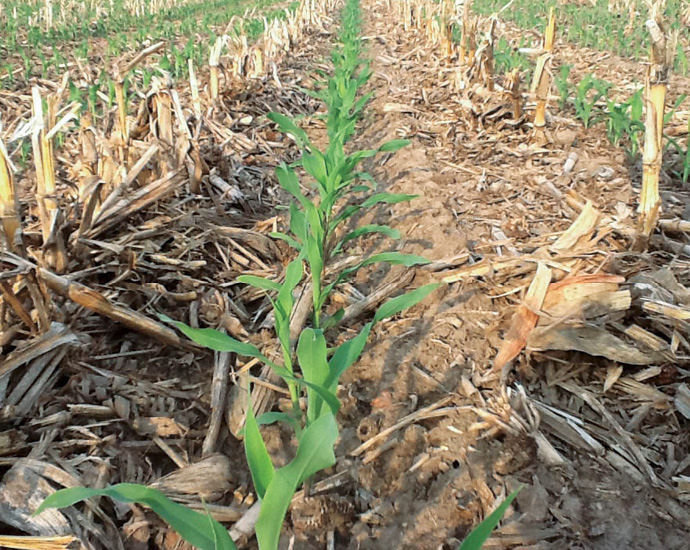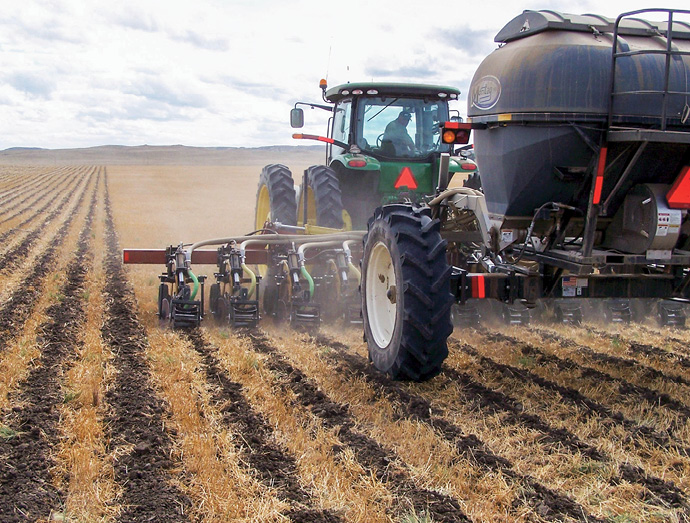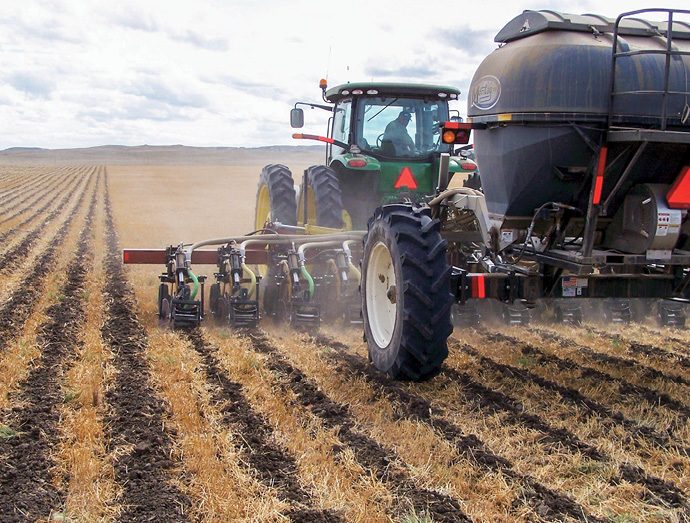Chris Hopkins has been selling strip-till equipment and helping growers polish their strip-till skills for the past 8 years. He says that once they get the hang of it, they almost always stick with it because they can see its inherent benefits almost immediately. Convincing farmers to work with it in the first place is the bigger challenge.
“Trying to get growers to leave that pretty, clean, harrowed land in exchange for strip-till is tough because everyone likes the beauty and the look of a clean harrowed disced field,” he says. “It looks pretty and there’s nothing like the smell of freshly turned soil.”
Hopkins is store manager of Lasseter Equipment Group’s Lyons, Ga., location. In all, Lasseter operates 7 John Deere dealerships throughout southern Georgia. Prior to joining the dealership, he was a cotton consultant and a county extension agent for 8 years, so he has a good level of agronomic experience that has served him well at the dealership. It’s particularly helpful when selling processes like strip-tillage. He is also a farmer.
Hopkins says that converting older generation farmers to strip-till is an even bigger challenge. “They call it ‘ugly farming.’ On top of this, I know it isn’t easy for them to just sit there and do nothing in early spring when all that’s really needed for strip-till is an herbicide program. They feel they need to be out there with a bottom plow and a disc. You know, it’s hard to get them to stop doing that.”
Growing Potential
Despite the hurdles inherent in getting growers to change any traditional cropping practice, Hopkins, who estimates that he’s currently working with 100 or so growers, believes there is great long-term potential to increase strip-till in his area of the world for crops ranging from cotton and peanuts to soybeans and corn.
“I believe there’s a high probability that it will continue to grow as people look for ways to save input costs and as producers become more conservation minded.”

Two of the hottest topics in agriculture today are cover crops and nutrient management, says Gary Fennig of Fennig Equipment, a shortline-only dealer in Coldwater, Ohio. Both are natural complements to a complete strip-till system.
Dealers Leroy Pedersen of Koletzky Implement, a single-store New Holland dealer in Yankton, S.D., and Gary Fennig of Fennig Equipment, a shortline-only dealer in Coldwater, Ohio, agree with Hopkins’ assessment of strip-till’s potential.
“Strip-till is very cost effective once you get your initial machine costs out of the way because you’re lowering your cost of inputs, including fuel and fertilizer, as well as your time,” says Pedersen. “You’re putting the fertilizer down where it needs to be in an environmentally friendly way and sealing it up right away. So, it’s not laying on top of the soil to runoff or evaporate.”
Pedersen adds that the dealership, which handles Kuhn Krause equipment, has sold 9 strip-till units in the past couple of years and it’s currently being used on an estimated 20,000 acres of corn and soybeans.
“I see it growing very rapidly, especially with the grain markets we have today,” says Fennig. “Farmers are wanting to cut passes across the field and get rid of some of the really expensive equipment they have sitting in their sheds that they’re not using. I think strip-till is becoming more popular because they’re being pushed by need to control the placement of nutrients. Nutrient placement and strip-till go hand-in-hand. There’s a big push on the environmental concerns, but I think cost is right behind the environmental push,” he says.
Dedicated strip-tillers have demonstrated the advantages of the practice in many cropping scenarios and in various regions of the country. Despite this, converting farmers who traditionally utilize conventional tillage methods to strip-till is challenging for any number of reasons. But the current downturn in commodity prices is prompting even skeptics to give it a closer look.
Identifiable Benefits
Growing emphasis on soil health and nutrient placement is what’s moving more growers to consider strip-tillage, according to Fennig, who has been handling Yetter equipment for the past 6 years. “The guys who have been using it have shown that they’re able to cut back on the nutrients that they apply to grow the crop for the simple fact that they’re putting those nutrients right where they need to be.
“Also what current users have experienced in drier years is when that crop develops, the roots will follow the mole knife where the fertilizer is placed. In a deep placement scenario,” he says, “come July when all the other corn is shriveled up and turning different colors, the strip-till guys are noticing that their corn keeps growing because it has the fertilizer right at the roots. Along with nutrient placement, fuel savings and reducing passes across the field are some of the biggest advantages they’ve seen with the practice.”
Fewer passes also means less compaction of the soil, something that’s also gotten more attention in recent years. “They’re not going across the field nearly as much with strip-till as they would with conventional tools because they can do a lot of things in a single pass with a strip-till unit,” adds Fennig.
It’s a great time for a dealership to get on board and offer something to the market in the form of a complete strip-till unit…
With declining commodity prices, fewer field passes has taken on increased precedence, according to Fennig. “The farmer thinks differently with $3.50 corn vs. $8 corn. With $3.50 corn, their minds start turning to things they can do to still grow the 200 bushel an acre corn, but do it in fewer passes.”
Basically, strip-tillers can eliminate a couple of passes, one in the fall and one in the spring, according to Pedersen. “It’s basically a minimum tillage tool where the grower leaves his old rows standing, goes in between them and has a tremendous seed bed that’s 7 inches wide tilled and ready for the next planting season.”
More recently, Hopkins says, another benefit his strip-till customers have been reporting comes by way of weed control. “We’re using a heavy rye cover crop that after it’s sprayed and killed creates a dense matt. This prohibits sunlight from reaching the ground and slows or prohibits the germination of pigweed seeds.”
At the same time, the proliferation of this nuisance has become a challenge to keep farmers in strip-till. Typically, farmers let winter weeds grow and kill them with a spring herbicide and then strip-till into them.
“But here in Georgia, pigweed has become glyphosate resistant. So it’s a big deal for us in producing cotton. By being able to plant a heavy cover crop, we not only slow down the pigweed growth, but in our really well drained sandy soils it provides organic matter and a barrier to the sun and keeps our sandy soils from drying out,” he says.
Because the pigweed has become resistant to some herbicides, some growers feel they need to abandon strip-tillage and return to conventional cultivation techniques to control it. “Our major challenge is trying to encourage producers to plant a heavy cover crop to control the pigweed,” says Hopkins, and not all of them want to go in that direction.
Required Dealer Expertise
As far as servicing his strip-till customers, Fennig says it does require some hand holding, especially at first. He believes that strip-till is a niche and requires a dealer have some in-depth knowledge of fertilizer placement and attachments. Fennig Equipment handles the Yetter line of equipment for nutrient and manure placement.
“I’m not going to call it expertise,” he says. “I would say it’s more a matter of thinking outside the box. If you’re a dealer who just handles the mainline equipment, strip-till is probably not for you because you need to think more about nutrient placement, making strips, applying nutrients 5, 6 or 7 inches deep or just a couple inches deep with a strip-till unit. That really sets the dealers involved in strip-till apart from the other dealers who sell equipment.
“You can’t expect to sell a strip-till rig without going out there and helping the farmer get it set properly so that it’s doing the best job possible for his conditions. This is part of my job as a dealer.”
For example, Fennig says, “You need to consider the horsepower tractor he wants to use, the nutrient application, if he’s going to be applying dry at the same time he’s making a strip or liquid if he’s making a strip. Some guys want to place fertilizer 7-8 inches deep. Some want it just a couple inches deep. So do you recommend a mole knife on the strip-till rig or just a couple coulters to place fertilizer?”
Hopkins believes to be successful in selling and servicing strip-till equipment the dealer needs to go deeper than merely having knowledge of the mechanical requirements of the equipment.
“You have to be somewhat of an agronomist to help fine-tune that situation. You need to know about the farmer’s soil type and then what type of strip-till equipment is needed so it can be set up properly. You’ve got to know what weeds he’s up against so you can determine what type of cover crops to select and at least a little bit about how to manage the cover crop,” says Hopkins.
The last thing a dealer wants is for the farmer to throw his hands up in the air when he attempts to strip-till and it doesn’t work properly. “Otherwise, you’re going to have a dissatisfied customer and your sales of strip-till equipment will suffer.”

Dealers say the most challenging aspect of introducing strip-till to farmers is the initial investment in equipment. A 16 row strip-till rig can cost upward of $125,000, in addition to $20,000 for GPS guidance on the tractor.
Not a One-Time Deal
Hopkins says he’s found that it takes about 2 growing seasons for farmers to develop enough knowledge and confidence to the point where they’re not as reliant on their dealer. At the same time, he cautions that because of changing conditions a cookie cutter approach doesn’t work well either.
He says that often the equipment will require adjustments based upon the growing season and other factors. For example, on different years, a farmer will plant different cover crops, or possibly strip-till into wheat stubble. The rig will need to be set up accordingly.
“When planting after wheat, you need to figure out how to move the loose straw out of the way so the farmer gets good seed-to-soil contact. With a rye cover you’ll need to know how to lay down and properly orient that rye so it doesn’t get tangled up in the strip-till rig,” Hopkins says. “Based on these factors, you’ll need to determine speed, depth and down pressure for the different conditions.
“All of this can be intimidating to a salesperson. But if he’s willing to get in and work to understand the agronomics behind it, he can succeed selling strip-till equipment,” he says.
On the other hand, Pedersen has found that service requirements for their strip-till rigs center more on precision farming and variable-rate technologies, rather than the machine itself. “We’re expected to be very knowledgeable on the precision software needed to variable-rate liquid or dry fertilizers, guidance and field mapping. The strip-till equipment is easy to adjust and you don’t even need a wrench.”
He says every unit that Koletzky Implement has sold so far utilizes variable-rate and he expects that demands for this type of technology will continue to increase in the future. He estimates that variable-rate is being used on less than 50% of the acres in his region, “but it’s growing every year.”
“Precision plays a huge role in nutrient placement and nutrient placement and strip-till go hand-in-hand,” says Fennig.
Hurdles to Strip-Till
The dealers agree there are a few obstacles to introducing strip-tillage to farmers. The first and most challenging is the upfront investment in the equipment. The second is getting past the traditional cropping mindset of many growers.
“The initial cost is our first hurdle,” says Pedersen. ”Depending on the size, you’re looking at $125,000 for a 16 row unit. Then you have to factor in probably $20,000 for guidance on your tractor. And you’ll need a good size tractor to pull it; something between 10-20 horsepower per row. You’ll also need your land mapped efficiently and correctly to put the right fertilizer in the right place.”
Fennig agrees. “In today’s economy, it’s the expense. Strip-till units are not cheap. Air carts are not cheap. And you’re basically changing your way of farming. If you’re willing to do that, strip-till will definitely make you money in the long run with a lot less expense than the conventional way of doing it.”
He says, “You can have $100,000 wrapped up in it real quick.”
Both Hopkins and Fennig estimate the “learning curve” for the farmer to become proficient is probably 2 years and there’s “some hand holding” the dealer will need to do in the mean time.
“It’s not as simple as it is with conventional tillage where, if you mess up, you can simply go back out and disc the field and start over. It’s really a multi-step approach and you need to be thinking 6 months in advance about what you want to do prior to planting. This includes being proactive with applying residual herbicides instead of strictly relying on post-emergence applications.”
Fennig adds that dealers need to be upfront with farmers who are considering strip-till. “They need to know that they’re going to have to change their farming practices compared to how they’ve been doing it, and if they’re not willing to change, then they shouldn’t consider a strip-till scenario. They’re not going to be field cultivating; they’re not going to be chiseling. They’re going to have to be open minded about using some kind of an air cart or an air system to apply that dry fertilizer or apply the liquid nutrient needed to grow the crop. Strip-till is just half of it. The other half is the nutrients that go along with it that they can apply at the same time they’re making the strip.”
Strip-Till: A Long-Term Trend
The dealers interviewed for this report agree that strip-tillage has tremendous potential for increased use. Fennig and Hopkins also believe that as strip-tillage acres increase, the industry will also see the growth of the use of cover crops.
“With $8 corn, farmers don’t really care much about strip-till or cover crops. They’ll drive their tractor; they’ll do the extra tillage pass. But when it comes to $3.50 corn, the farmer tries to still produce the 200 bushel corn with a lot less expense.
“There are a lot of strip-till guys out there who are trying to incorporate a cover crop at the same time. Nutrient management and cover crops are the two hottest topics in agriculture today. Whenever you can combine these two, you’ve pretty much got the complete package,” Fennig says.
He adds that if farmers who start strip-tilling stick with it for 3-4 years, they’ll stick with it for a long time. “He’ll definitely see the benefit and he’ll be the one outshining his neighbor when his neighbor’s out there making 3 or 4 passes to get the crop planted and he’s done in 2 passes.”
Pedersen believes the reduction in input costs will also convince more growers to give strip-till more than a passing glance. “The strip-tillers we’ve talked to say they’re getting $40-$50 per acre in hard savings in fuel and fertilizer, and seeing an average of 8-12 bushels an acre yield increase on dryland and up to 20 bushels on irrigated acres above what is not strip-tilled.”
But there’s even more to be gained beyond the financial savings that farmers are experiencing, according to Hopkins. “As long as there are dollars associated with it, whether it’s in cost reductions or yield increases, you’ll find producers will migrate toward it. The farmer with strip-till equipment can accomplish more work with less labor because he’s making less equipment trips across the field. That’s going to be one reason why we adopt it,” he says.
“But we’ll also continue to adopt strip-tillage because, ultimately, conservation should be our number one concern. We need to leave agriculture better than we found it for the sake of the generations that come after us.”
Back To Story Intro Growers: Supporting Strip-Till Goes Beyond the Machinery







